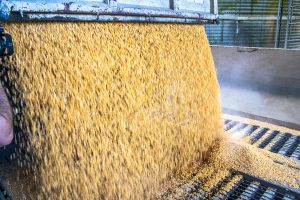
One of the most common problems in material handling is how to get material to flow properly. Many materials have a tendency to clump, cake, or interlock during storage or mixing. That can impact the entire production process, and lead to unnecessary costs and safety issues.
Types of material blocks
Some materials have cohesive properties that cause particles to stick together. This can lead to bridging or ratholing.
During bridging, the material forms an arch above the outlet of the silo or hopper. The particles interlock and bond together because of cohesive strength and internal friction, while the wall friction holds up the ends of the arch.
During ratholing, the material adheres to the container sides, so the flow is limited to just above the container outlet. As more material flows through and accumulates on the walls, the block becomes bigger and more compact.
Bridging and ratholing can lead to all sorts of problems with bulk material handling. It slows down production, causes material waste, and compromises the formula’s consistency and quality. And if workers have to clear the blocks manually—by hammering or even climbing down into silos or hoppers with pick axes—they’re at risk for injury and unnecessary exposure to the material.
Problematic powders
About 50% of manufactured materials use powders at some stage of production. However, many powders are cohesive, which means they have a tendency to cake or become compact under their own mass.
Food ingredients
Some powders like flour have “easy” flow properties; any chunks can be broken apart with gentle aeration. However, heavier powders like cocoa, lecithin, whey, milk, sugar and sweeteners, spices, or even binders and preservatives will form solid, rock-hard chunks.
The food industry also needs to achieve first in/first out flow to avoid stagnant material that can spoil, thus compromising the product’s safety and breaking strict regulations on sanitation and hygiene.
Spoiled material and off-spec batches need to be thrown away, and even a single “bad batch” that escapes quality control can lead to product recalls.
Pharmaceutical powders
An estimated 60% of pharmaceutical sales come from powder formulations such as tablets, capsules, sachets, or inhalable powders.
During processing, pharmaceutical powders will go through several phases where they are exposed to moisture and air. These environmental factors—and variables in properties like size, shape, and texture—affect the flow properties, density, compressibility, and permeability.
These can pose numerous problems in material handling that must be managed well to ensure product efficacy and safety. Pharmaceuticals rely on precise measurements and proportions of ingredients. Material blocks can ruin an entire batch, and lead to material waste or even product recalls.
Grain products
One of the most common problems in material handling arises when conveying grain products from storage silos or bins. The materials may have sat motionless for days or even weeks, and have settled and become more compact. So, their flow properties are very different from powders or granules in aerated samples.
Some examples of common grain products are cornstarch, wheat bran, polenta, tapioca, couscous, rice, and hops. These are used in the food, pet food, beverage, nutraceutical, cosmetic and biofuel industries.
Cement powders
Cement uses many types of powders, including limestone, chalk, glass powder, and steel slag powder (SSP). Sometimes, granite powder is used in place of sand.
These materials all have unique flow properties, and the challenges increase when they are mixed and become sticky, moist, and heavy. Many cement plants have issues with materials bridging over silos and hoppers, which can slow down production speed and vessel capacity by as much as 80%.
Chemical powders
Many industries use chemicals either as a main material, or as a binder, preservative, or enhancer. For example, rubber tire manufacturers use carbon black to improve durability and performance. Battery manufacturers use lithium chloride and carbonate.
These chemicals can cause problems in material handling if they have a high moisture content, or have high cohesive properties. Some materials like carbon black tend to fluidize, forming deposits along the conveyor lines and storage vessels. Since it does not dissolve in water and solvents, cleaning can be time-consuming and expensive.
AirSweep solves problems in material handling
Leading companies in different industries rely on AirSweep to prevent bridging, ratholing, and other problems in material handling. Each nozzle emits a high-pressure, high-volume, 360-degree burst of compressed air to lift and sweep stalled material back into the flow stream – clearing the way for higher factory and material handling efficiency.
- Watch material flow videos to see how AirSweep can activate even the toughest materials, from heavy powders to sticky and moist solids
- Read case studies on how companies have increased productivity and reduced costs after installing an AirSweep system
- Compare AirSweep with other flow aids and find out why it works better than vibrators, fluidizers, and air cannons
You can also contact us to get a personalized consultation on how AirSweep can solve the specific problems in material handling that you encounter in your plant.





Comments are closed